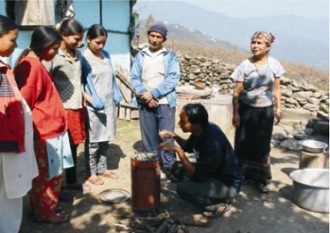Sci Total Environ. 2009 Aug 15;407(17):4870-5.
Characteritization of, and health risks from, polychlorinated dibenzo-p-dioxins/dibenzofurans from incense burned in a temple.
Hu MT, Chen SJ, Huang KL, Lin YC, Lee WJ, Chang-Chien GP, Tsai JH, Lee JT, Chiu CH.
Department of Environmental Engineering Science, National Pingtung University of Science and Technology, Pingtung 91201, Taiwan.
Polychlorinated dibenzo-p-dioxins/dibenzofurans (PCDD/Fs) may cause adverse health effects. However, PCDD/F emissions from burning incense in temples have rarely been addressed. This study investigates PCDD/F emissions from burning incense in a temple. The mean total PCDD/F concentrations were 72.4-82.2 pg
Nm(-3) at two indoor sites; their corresponding mean total PCDD/Fs I-TEQ concentrations (0.24-0.27 pg I-TEQ Nm(-3)) were approximately 11 times that at a background location. In air samples collected from burning incense, OCDFs accounted for approximately 90% of total PCDD/Fs at the two indoor sites and an
outdoor site near the temple, while the major PCDD/Fs in incense ash were PCDDs. The total PCDD/F content and toxic equivalent value of incense ash were 617 pg g(-1) and 1.55 pg I-TEQ g(-1), respectively. At the three sites inside/outside the temple, the air and ash samples contained the same four primary PCDD/Fs-OCDD, 1,2,3,4,6,7,8-HpCDD, OCDF and 1,2,3,4,6,7,8-HpCDF. The Cl- emission factor, which is related to the PCDD/F formation, from burning incense was 0.454 mg g(-1). The resultant lifetime average daily dose and cancer risk for temple workers were 0.00964 pg I-TEQ day(-1) kg(-1) and 9.64 x 10(-6), respectively, approximately 2 times that for residents near the temple (0.00489 pg I-TEQ day(-1) kg(-1) and 4.89 x 10(-6), respectively). We suggest that the chlorine content in incense must be regulated, and the high risk of PCDD/F exposure from burning incense for temple workers and visitors should be of concern.



